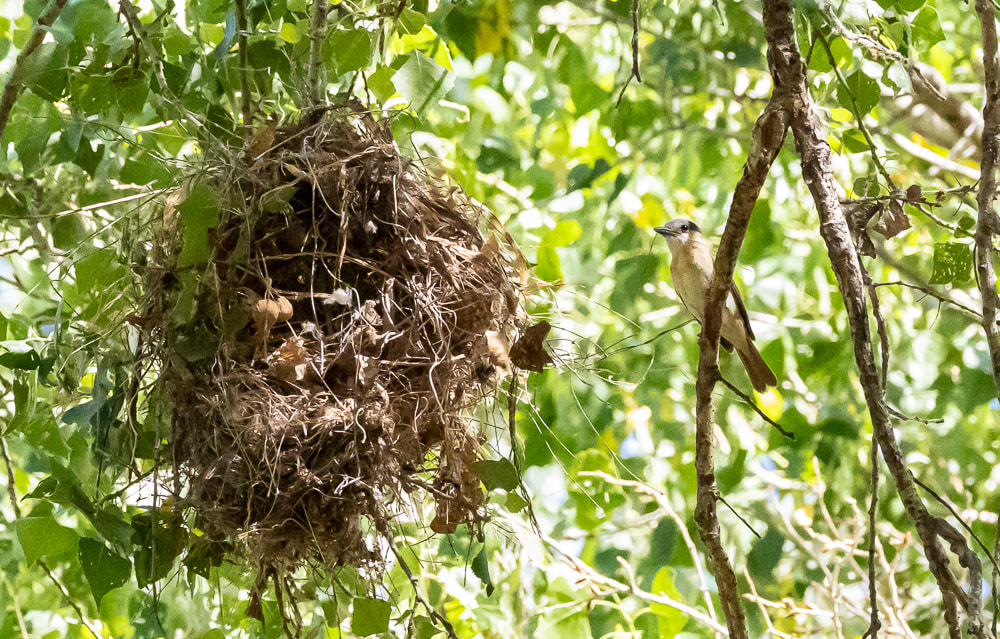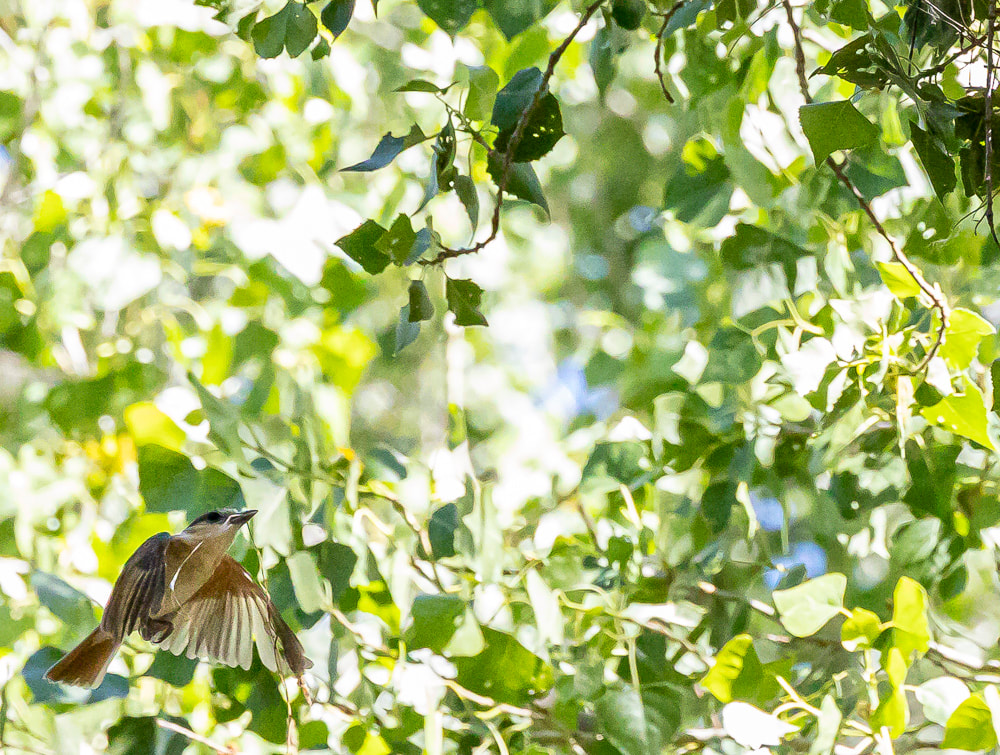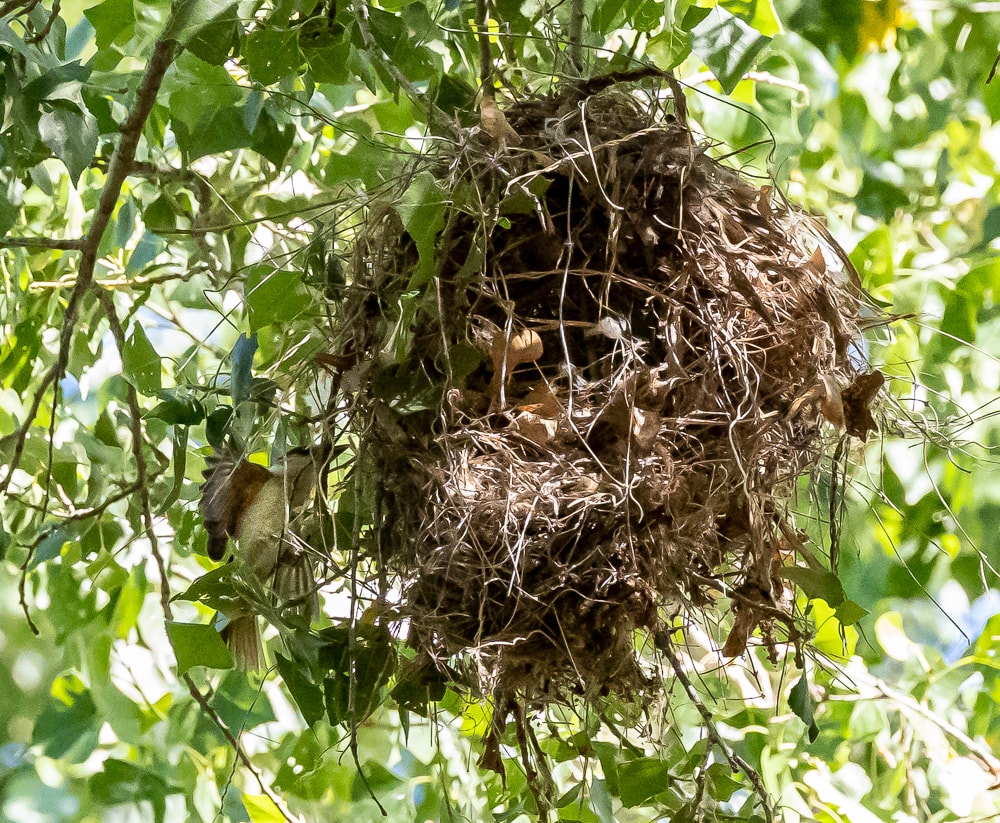|
Cottonwood trees in morning light adjacent to the Santa Cruz River in Tubac. The bridge across the river is just visible to the far right of the photograph.
One of the regular nesters in this section of the Santa Cruz is the Rose-throated Becard, a flycatcher and the sole member of the subtropical and tropical family Tityridae (Ref: Birds of the World). They live year round in Central America and southern Mexico, with breeding populations extending north just up across the border into the southern tip of Texas and SE Arizona. They are so rare in the U.S. that Cornell's website All About Birds does not include them, but Birds of the World (a subscription site) does, as well as Audubon's online field guide. So, any birder in the U.S. who is doing a "Big Year" or adding to their life list flocks (!) to the Anza Trail in the spring and summer looking for this rare flycatcher. The Cottonwoods on the river bank are spectacular creating a natural cathedral lit by the morning sun. For the photo geeks: All landscape photos captured with an iPhone 13. On this day we did find a female Rose-throated Becard building her nest, high up in trees, hanging from a branch. These nests are usually built by a breeding pair, but this day we did not see the male. Note that his may be my first post in 6 years on a single species. I did capture images of other birds on our walk, but almost everything else seems like a let down! So here we go . . . . Rose-throated BecardCanon R6 with RF 100-500mm and 1.4x Extender, 420 mm, f/10, 1/4000 sec., ISO 32,000. Exposure bias +1 1/3 stops (EV). In the image above we see the female sitting on a branch next to her nest. Nests hang from branches and are constructed of sticks brought to the nest by both male and female. As mentioned earlier we did not see the male this day. For more on nest placement and construction, see Cornell's site, Birds of the World (subscription required). I was able to get a series of photographs of three separate trips to the nest by the female carrying twigs. For the photo-geeks: This nest was high in the trees, with very marginal light. I wanted to catch the bird in flight, since it was quickly apparent that she did not sit still for long, and once she took off for the nest, she made it to the side entrance pronto! I switched early on from mechanical shutter to electronic (Canon R6) shooting at 20 frames/second, generally at 1/2500 to 1/4000 second, with high ISO's that required some noise suppression post production. All shots were hand-held, although a tripod would have been nice. I have added camera data for each series, below. Trip #1Canon R6 with RF 100-500mm and 1.4x Extender, 700 mm, f/10, 1/4000 sec., ISO 40,000. Exposure bias +1 stop (EV). Series shot with electronic shutter (silent) at 20 frames/second, hand held. Frames shown are selected from ~20 images shot. The female would perch with a twig in her bill well away from the nest, and well out of the camera frame. She would then take off and enter the side entrance to the nest, on the left from this view. This nest looks like a basketball hanging in the tree. Trip #2These were shot at 20 frames/second, 1/2500 second. I hit the shutter as soon as I thought she was in flight. In the picture above we can see her approaching the nest, and can get a sense of scale. This is a big nest. The image below is the same as above, but cropped to show more detail of the bird. The female has a dark crown, and is rusty to rufous above and cinnamon to yellow below (Ref: Birds of the World). We can see the twig in the bill as she heads to the nest. Building a nest like this must take a lot of trips. A bit like building a brick home by carrying one brick at a time from Home Depot. She approaches the nest then makes her dive for the entrance. Trip #3Canon R6 with RF 100-500mm and 1.4x Extender,420 mm, f/9.4, 1/4000 sec., ISO 20,000. Exposure bias +1 1/3 stop (EV). Series shot with electronic shutter (silent) at 20 frames/second, hand held. Frames shown are selected from ~20 images shot. We all know that in our world, not everything goes as planned. So too for this bird as she makes another run with a twig in her bill. Above, she is perched to the right of the nest. Below, she takes off, and it appears that the twig is hung up on the branch, pulling her head back. Ouch! Above, it looks like she is doing a somersault mid-air. It appears that the twig has come free and she hangs onto it. She frees the twig and keeps flying, but appears to be off course (understandably!) and flies past the nest. She flies past the nest and climbs up and out of the frame to the left. We get good views of her underside and wings. When the tail feathers come together they look slightly forked. Twig in her beak, she is likely off to another perch to try again. Since we did not see a male Red-throated Becard on the 20th, I went through my archives and found a post from the Audubon Festival in 2017. Speaking of the Tucson Audubon festival, the annual Southeast Arizona Birding Festival will be August 10-14, 2022, at the DoubleTree by Hilton at Reid Park. Registration opens April 26th at 10 am MST (Arizona). I will be leading a photography workshop on Mt Lemmon on Friday the 12th of August. Check out the registration website. From the 2017 Archives: A Male Rose-throated BecardCanon 6D, Sigma 150-600mm C at 600mm, 1/500 sec., f/8.0, ISO 1000. During the Audubon Festival in 2017 we went on a field trip with Richard Fray that included a stop at the de Anza Trail near Tumacacori, where we located a male and female Red-throated Becard and their nest. In the picture above we see the nest hanging from branches, and the female sitting to the right. Canon 6D, Sigma 150-600mm C at 600mm, 1/500 sec., f/8.0, ISO 320. The male was much harder to locate, and even more difficult to photograph. He kept on the move on higher branches. I was able to capture these images. Above, he is almost handing upside down from a branch. Below he perches for a moment and we can see the rose colored throat characteristic of the species. Canon 6D, Sigma 150-600mm C at 600mm, 1/500 sec., f/8.0, ISO 640. That's all for now! More coming soon.
Happy Trails!
10 Comments
Melanie Garliepp
4/24/2022 04:11:00 pm
I always enjoy your beautiful photos 😊
Reply
4/24/2022 07:40:54 pm
Another nice job Henry - a very unusual and rare bird for Arizona - great photos.
Reply
Janet L Davies
4/24/2022 08:20:54 pm
Wow! such beautiful pictures.
Reply
Pam Winsten
4/25/2022 06:57:55 am
Your photographs are unusually clear and crisp. Delightful! Your narrative, your story telling, adds so much that I feel like I was there experiencing it with you. Thank you for the refreshing experience Henry!
Reply
Linda Currin
4/25/2022 08:15:32 am
Another incredible example of your expertise, patience, talents and perseverance, Henry! Thank you for sharing.
Reply
Henry Johnson
4/25/2022 08:43:19 am
Thanks everyone! I am glad you enjoyed the post. Spring is a great time to get out and enjoy the birds. Have a great day!
Reply
Marty Herde
4/26/2022 09:34:31 am
Hi Henry! Amazing flight shots of the Becard! I sure hope the male shows up soon to admire the amazing nest!
Reply
Joan
12/30/2023 10:46:12 am
Henry, I am here in Ohio. short distance from Lake Erie.
Reply
Henry Johnson
12/30/2023 03:34:23 pm
Joan: See my reply that follows as the next comment.
Reply
Henry Johnson
12/30/2023 12:55:25 pm
Joan: Many thanks for your question. I checked eBird. I cannot reproduce their range map (based on sightings) in a comment field, but the bird's range is from Panama north into Mexico, up as far as NW Mexico, into SE Arizona (for breeding), with some sightings in Texas. Nothing north of there, and no sightings in Ohio this week. For more information look-up the Rose-throated Becard on eBird.
Reply
Leave a Reply. |
AuthorHenry Johnson, photographer and author of this site. For more detail, see About
Categories
All
Archives
July 2024
|
























 RSS Feed
RSS Feed